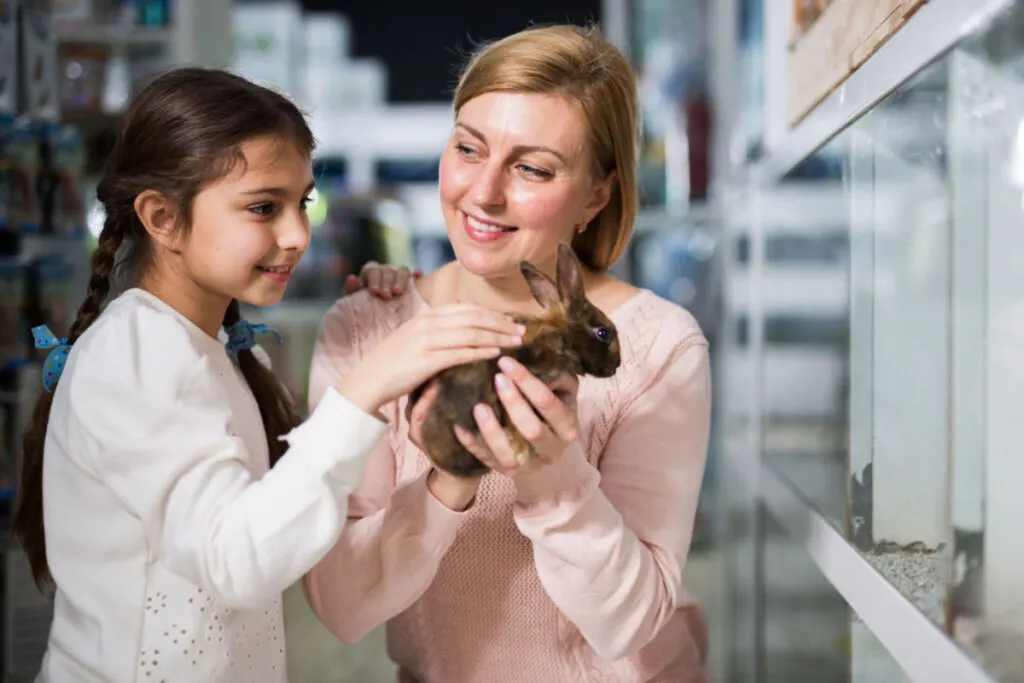Have you ever held a rabbit and you can tell they want to get out? You have to hold on tight just to keep them from jumping out of your lap. The moment you take a bit of pressure off, you can tell they are wound tight, ready to spring away to freedom.
Holding a rabbit can be a tricky business. A lot of people move too quickly and try to hold their rabbits before they are ready.

Owning a rabbit can be a ton of fun, but too many people have a cartoon image of what having a pet rabbit should be like. They think it’s all snuggling and cozy cuddling whenever they want.
Rabbits, however, don’t always love to be held. Most of them only want to be held by people they trust completely. These animals are, by nature, skittish and wary of would-be predators. It takes time for them to trust humans enough to want to be held.
There are some ways you can build trust with your rabbit to the point they will like being held. It takes time and patience, but it can be done.
Here are seven tips on how you can teach your rabbit to like being held. When it happens, it’s a very rewarding feeling.
Tip 1 – Be Gentle
Rabbits are creatures of habit. They are capable of learning what they like and don’t like, what constitutes a threat, and who they can trust.
If you’re rough with your rabbits, they will likely never want to be held by you. It can be frustrating if your rabbit is always running away from you.
You probably got a pet rabbit dreaming of cuddling on the couch with your fluffy pet. Reality is sometimes different. Not every rabbit is the same, and each will vary in how much they like to be held.
You should remain gentle in your interactions with your rabbit at all times. If you move too aggressively and try to force your rabbit onto your lap, it’s going to make things harder long-term.
Tip 2 – Keep Their Legs Supported

Rabbits like to have a sure footing at all times. When you’re holding your rabbit, make sure you keep all four of their legs supported with your arm, legs, or hand. They could panic if they feel like they can’t move if they want to.
The person holding the rabbit will also probably panic if the rabbit’s legs start whirling in the air. They may drop the rabbit and hurt the animal: something you want to avoid.
Tip 3 – Use Treats to Encourage Them
Rabbits, like other animals, respond very well to treats. Things like carrots, lettuce, and other treats will get them to come to you and, with work, can get them into your lap.
They’ll associate being held with getting treats and will be way more open to being held if they know they are likely to get a tasty treat if they stay in your lap. Treats are a very effective way to train certain behaviors in your rabbit.
Only give them healthy treats, though, because you don’t want to make them sick by giving them human foods that they shouldn’t eat.
Tip 4 – Use Soothing Words of Encouragement

Rabbits like to hear soft, soothing words. If you’re picking up your rabbit and want them to trust you, talk to them with a soothing voice and encourage them when they jump on your lap or make any other incremental move closer to being held.
If you do get to hold them, make sure you give them plenty of positive reinforcement when you’re holding them. It will help train them to associate being held with rewards.
Tip 5 – Let Your Rabbit Come to You
Don’t try to chase your bunny into a corner where you can scoop them up. This may be a nice short-term way to pick them up, but it’s going to scare them and make them run away from you down the road. Instead, put some treats around you and let your rabbit explore for itself.
They’ll hop around you, survey the scene, sniff you, and will eventually warm up to you and trust you. Once there is a trust established, your rabbit is much more likely to let you hold them and enjoy the experience.
Tip 6 – Supervise Other People Who Hold Your Rabbit

Keep an eye on other people who hold your rabbit, especially children. Other people aren’t as invested in your rabbit as you are, and they are more likely to panic and drop your pet.
You should stay close to your rabbit when other people are holding it.
The best thing to do is probably to have them sit in a chair or on a couch and place the rabbit on their lap to start. It avoids them dropping your rabbit on a hard floor. If someone else holds the rabbit incorrectly or drops them, it will erase all of the hard work you’ve done building trust with your rabbit.
Tip 7 – Be Gentle, But Firm
Your rabbit needs to feel safe and secure in your arms when you’re holding it. If you’re constantly changing positions or grips, they may feel unsafe and try to get away. They want to feel safe, and the best way for you to do that is to keep a firm hold on them at all times.
Don’t squeeze them too tightly, but send the message that your rabbit is OK and isn’t at risk of being dropped.
Final Thoughts
Getting your rabbit to like being held takes time. How soon you can hold your rabbit will depend on your rabbit’s personality and the work you put into building trust with your bunny.
Keep at it and stay patient. Use treats and do what you can to keep your rabbit safe at all times.
Eventually, your rabbit will love being held and will come up and hop into your lap to spend time with you of its own accord.
